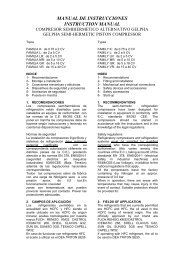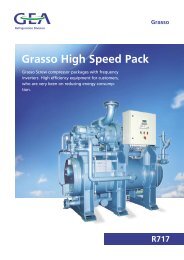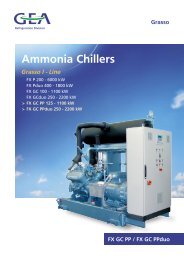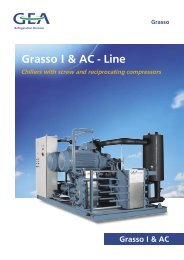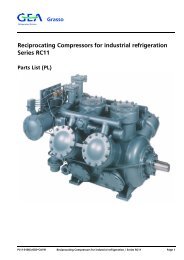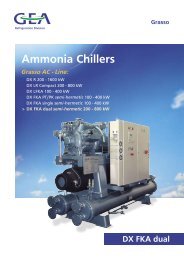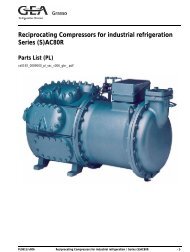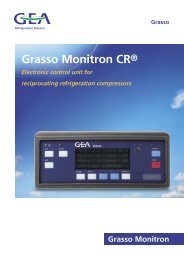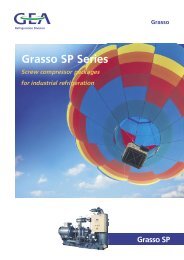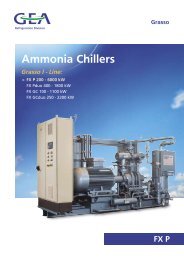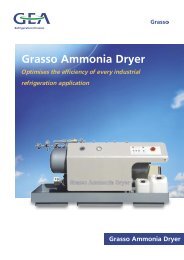RC(U)6 Installation and Maintenance Manual - Marine Refrigeration ...
RC(U)6 Installation and Maintenance Manual - Marine Refrigeration ...
RC(U)6 Installation and Maintenance Manual - Marine Refrigeration ...
Create successful ePaper yourself
Turn your PDF publications into a flip-book with our unique Google optimized e-Paper software.
<strong>Refrigeration</strong> Division<br />
Grasso<br />
B3 STEPS FOR LONGER SHUT-DOWN PERIODS<br />
(> 6 months)<br />
To shut down a compressor for long term periods,<br />
proceed as follows:<br />
a) Tightly shut both the suction <strong>and</strong> discharge stop<br />
valves <strong>and</strong> the stop valve of the oil return line (if<br />
present).<br />
b) Disconnect the power source from the compressor<br />
drive motor <strong>and</strong> the electrical control cabinet of the<br />
Monitron CR (if present).<br />
c) Place a moisture absorbing compound (eg a<br />
dessicant such as silica gel) inside the control cabinet.<br />
d) Place warning tags on the electric system <strong>and</strong> all<br />
closed stop valves.<br />
Prior to starting up after a shut down, change the oil<br />
(refer to §B6) <strong>and</strong> clean or exchange the oil filters (refer<br />
to §B7). Determine the starting <strong>and</strong> stopping<br />
procedure from §A2.10 prior to start the compressor.<br />
B4 LUBRICATION DATA<br />
Determine max Toil <strong>and</strong> set this value in the safety<br />
device (Monitron CR, if present).<br />
Change the oil as soon as an oil analysis (refer to<br />
§B2.2 for frequency) indicates contaminated oil.<br />
It is expressly pointed out that it is not<br />
permitted to mix different types of oil. If<br />
another type of oil is used, first remove<br />
all the stale oil in the filters, oil pump,<br />
crankcase, shaft seal, oil separator <strong>and</strong><br />
oil drains of the installation.<br />
B4.1 Topping up oil with compressor operating<br />
Topping up oil is permitted during compressor<br />
operation.<br />
Be sure that this oil is the same as in the plant<br />
(refer to §B4).<br />
B: INSPECTION, MAINTENANCE<br />
AND TROUBLE SHOOTING<br />
Without affecting the operation of the compressor,<br />
the oil may be topped up by means of a separate oil<br />
pump. This pump enables the oil to be forced into the<br />
crankcase via the oil charging valve, against suction<br />
pressure. If this oil pump is not available, oil can be<br />
charged by reducing the crankcase pressure to below<br />
atmospheric pressure.<br />
The procedure is as follows:<br />
a) Connect a hose to the oil charging valve after<br />
removing the cap nut.<br />
b) Fill the hose with oil <strong>and</strong> immerse its loose end in a<br />
reservoir containing sufficient oil.<br />
c) Close the suction stop valve so, that the suction<br />
pressure falls below the atmospheric pressure.<br />
d) Keep the oil charge valve open as long as the oil in<br />
the crankcase has attained the required level again.<br />
Take care that no air is being drawn into the<br />
crankcase.<br />
e) Slowly open the suction stop valve to avoid liquid<br />
hammer which may damage the compressor.<br />
f) Remove the hose <strong>and</strong> replace the cap nut with<br />
gasket onto the oil charging valve.<br />
Fig. B1 Oil level in compressor sight glass<br />
B1.4 <strong>Installation</strong> <strong>and</strong> <strong>Maintenance</strong> <strong>Manual</strong> <strong>RC</strong>(U)6 v001.99.01.en



